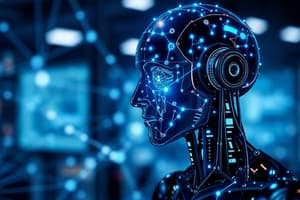Podcast
Questions and Answers
What is the function of the activation function in a neuron within an ANN?
What is the function of the activation function in a neuron within an ANN?
- To calculate the total input signal.
- To measure the accuracy of predictions.
- To introduce non-linearity into the model. (correct)
- To determine the network's structure.
Which of the following layers is NOT typically found in an artificial neural network?
Which of the following layers is NOT typically found in an artificial neural network?
- Hidden Layers
- Input Layer
- Output Layer
- Maintenance Layer (correct)
In the context of ANNs, what is the primary purpose of the backpropagation algorithm during training?
In the context of ANNs, what is the primary purpose of the backpropagation algorithm during training?
- To update the weights based on prediction errors. (correct)
- To encode the input data more efficiently.
- To increase the number of layers in the network.
- To reduce the training time of the network.
Which of the following is a common application of ANNs in the finance sector?
Which of the following is a common application of ANNs in the finance sector?
Which of the following statements about ANNs is incorrect?
Which of the following statements about ANNs is incorrect?
In what area have John Hopfield and Geoffrey Hinton made significant contributions?
In what area have John Hopfield and Geoffrey Hinton made significant contributions?
What type of learning process is primarily used in ANNs?
What type of learning process is primarily used in ANNs?
Which of the following is NOT a typical application of ANNs?
Which of the following is NOT a typical application of ANNs?
What role do hidden layers play in an ANN?
What role do hidden layers play in an ANN?
Which component of an ANN is adjusted during the training process to reduce prediction errors?
Which component of an ANN is adjusted during the training process to reduce prediction errors?
What is the primary goal of the training process in Artificial Neural Networks (ANNs)?
What is the primary goal of the training process in Artificial Neural Networks (ANNs)?
Artificial Neural Networks are solely used for image recognition tasks.
Artificial Neural Networks are solely used for image recognition tasks.
What are the three main types of layers in a typical Artificial Neural Network?
What are the three main types of layers in a typical Artificial Neural Network?
The ______ layer in an ANN receives the initial data, while the ______ layer produces the final output.
The ______ layer in an ANN receives the initial data, while the ______ layer produces the final output.
Match each field of application with a corresponding example of how Artificial Neural Networks are used in that field.
Match each field of application with a corresponding example of how Artificial Neural Networks are used in that field.
Which of the following algorithms is commonly used in the training process of ANNs to minimize prediction errors?
Which of the following algorithms is commonly used in the training process of ANNs to minimize prediction errors?
The use of activation functions in ANNs is primarily intended to introduce non-linearity, allowing the network to model complex relationships.
The use of activation functions in ANNs is primarily intended to introduce non-linearity, allowing the network to model complex relationships.
What is the significance of the Nobel Prize in Physics awarded to John Hopfield and Geoffrey Hinton in October 2024?
What is the significance of the Nobel Prize in Physics awarded to John Hopfield and Geoffrey Hinton in October 2024?
Flashcards
What are Artificial Neural Networks (ANNs)?
What are Artificial Neural Networks (ANNs)?
Computational models inspired by the human brain, using interconnected nodes (neurons) to process data and learn.
What is the Input Layer?
What is the Input Layer?
The initial layer of an ANN that receives input data.
What are Hidden Layers?
What are Hidden Layers?
Intermediate layers within an ANN that process input data through weighted connections.
What is the Output Layer?
What is the Output Layer?
Signup and view all the flashcards
How do ANNs learn?
How do ANNs learn?
Signup and view all the flashcards
What is Backpropagation?
What is Backpropagation?
Signup and view all the flashcards
How are ANNs used in healthcare?
How are ANNs used in healthcare?
Signup and view all the flashcards
How are ANNs used in finance?
How are ANNs used in finance?
Signup and view all the flashcards
How are ANNs used in the automotive industry?
How are ANNs used in the automotive industry?
Signup and view all the flashcards
How are ANNs used in social media?
How are ANNs used in social media?
Signup and view all the flashcards
Structure of ANNs
Structure of ANNs
Signup and view all the flashcards
Activation Function
Activation Function
Signup and view all the flashcards
Training Process
Training Process
Signup and view all the flashcards
Applications in Aerospace
Applications in Aerospace
Signup and view all the flashcards
Role in Drug Discovery
Role in Drug Discovery
Signup and view all the flashcards
Nobel Prize in Physics 2024
Nobel Prize in Physics 2024
Signup and view all the flashcards
Pattern Recognition
Pattern Recognition
Signup and view all the flashcards
Industry Applications
Industry Applications
Signup and view all the flashcards
Study Notes
Artificial Neural Networks (ANNs)
- ANNs are computational models inspired by the human brain's interconnected neuron structure.
- They consist of layers of interconnected nodes (neurons) that process input signals, adjust connections (synaptic weights), and produce output signals.
- This architecture enables ANNs to learn from data, recognize patterns, and make decisions with minimal human intervention.
Structure of ANNs
- ANNs typically have three layers:
- Input Layer: Receives the initial data.
- Hidden Layers: Intermediate layers that process inputs through weighted connections.
- Output Layer: Produces the final output of the network.
- Each neuron applies an activation function to its input to introduce non-linearity, enabling the network to model complex relationships.
Learning Process
- ANNs learn through training, where the network adjusts its weights based on the error of its predictions compared to known outcomes.
- Algorithms like backpropagation are used to minimize the error by fine-tuning the weights.
- Over time, the network becomes proficient at tasks such as classification, regression, and pattern recognition.
Applications of ANNs
- Healthcare: Used for medical diagnosis, image analysis, and personalized treatment plans.
- Finance: Employed in stock market prediction, fraud detection, and risk assessment.
- Aerospace: Applied in aircraft component fault detection and flight path simulations.
- Automotive: Integral to the development of self-driving cars and advanced driver-assistance systems.
- Social Media: Power content recommendation systems and targeted advertising.
Recent Developments
- John Hopfield and Geoffrey Hinton were awarded the Nobel Prize in Physics in October 2024 for their pioneering work in ANNs.
- Their contributions significantly advanced the field of artificial intelligence, leading to applications in drug discovery, climate modeling, and particle physics.
Conclusion
- ANNs have revolutionized the way machines process information, enabling advancements in various fields by mimicking the human brain's learning processes.
- Further research promises even more sophisticated AI applications and improvements.
Studying That Suits You
Use AI to generate personalized quizzes and flashcards to suit your learning preferences.




